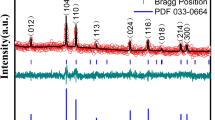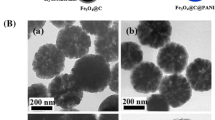Abstract
Porous α-Fe2O3 nanostructures have been synthesized by sol–gel route. The effect of preparation temperature on the morphology, structure, and electrochemical stability upon cycling has been studied for supercapacitor application. The discharge capacitance of α-Fe2O3 prepared at 300 °C is 193 F g−1, when the electrodes are cycled in 0.5 M Na2SO3 at a specific current of 1 A g−1. The capacitance retention after 1,000 cycles is about 92 % of the initial capacitance at a current density of 2 A g−1. The high discharge capacitance as well as stability of α-Fe2O3 electrodes is attributed to large surface area and porosity of the material. There is a decrease in specific capacitance (SC) on increasing the preparation temperature. As iron oxides are inexpensive, the synthetic route adopted for α-Fe2O3 in the present study is convenient and the SC is high with good cycling stability, the porous α-Fe2O3 is a potential material for supercapacitors.








Similar content being viewed by others
References
Arico AS, Bruce PG, Scrosati B, Tarascon JM, Schalkwijk WV (2005) Nanostructured materials for advanced energy conversion and storage devices. Nat Mater 4:366–377
Simon P, Gogotsi Y (2008) Materials for electrochemical capacitors. Nat Mater 7:845–854
Zhang J, Zhao XS (2012) On the configuration of supercapacitors for maximizing electrochemical performance. ChemSusChem 5:818–841
Hall PJ, Mirzaeian M, Fletcher SI, Sillars FB, Rennie AJR, Shitta GOB, Wilson G, Cruden A, Carter R (2010) Energy storage in electrochemical capacitors: designing functional materials to improve performance. Energy Environ Sci 3:1238–1251
Zhang LL, Zhao XS (2009) Carbon-based materials as supercapacitor electrodes. Chem Soc Rev 38:2520–2531
Wang G, Zhang L, Zhang J (2012) A review of electrode materials for electrochemical supercapacitors. Chem Soc Rev 41:797–827
Li C, Bai H, Shi G (2009) Conducting polymer nanomaterials: electrosynthesis and applications. Chem Soc Rev 38:2397–2409
Cottineau T, Toupin M, Delahaye T, Brousse T, Belanger D (2006) Nanostructured transition metal oxides for aqueous hybrid electrochemical supercapacitors. Appl Phys A 82:599–606
Hu CC, Chang KH, Lin MC, Wu YT (2006) Design and tailoring of the nanotubular arrayed architecture of hydrous RuO2 for next generation supercapacitors. Nano Lett 6:2690–2695
Yuan C, Zhang X, Su L, Gao B, Shen L (2009) Facile synthesis and self-assembly of hierarchical porous NiO nano/micro spherical superstructures for high performance supercapacitors. J Mater Chem 19:5772–5777
Jiang H, Zhao T, Li C, Ma J (2011) Hierarchical self-assembly of ultrathin nickel hydroxide nanoflakes for high-performance supercapacitors. J Mater Chem 21:3818–3823
Xiong S, Yuan C, Zhang X, Qian Y (2011) Mesoporous NiO with various hierarchical nanostructures by quasi-nanotubes/nanowires/nanorods self-assembly: controllable preparation and application in supercapacitors. CrystEngComm 13:626–632
Rakhi RB, Chen W, Cha D, Alshareef HN (2012) Substrate dependent self-organization of mesoporous cobalt oxide nanowires with remarkable pseudocapacitance. Nano Lett 12:2559–2567
Xia X, Tu J, Zhang Y, Mai Y, Wang X, Gu C, Zhao X (2012) Freestanding Co3O4 nanowire array for high performance supercapacitors. RSC Adv 2:1835–1841
Pang H, Gao F, Chen Q, Liu R, Lu Q (2012) Dendrite-like Co3O4 nanostructure and its applications in sensors, supercapacitors and catalysis. Dalton Trans 41:5862–5868
Devaraj S, Munichandraiah N (2008) Effect of crystallographic structure of MnO2 on its electrochemical capacitance properties. J Phys Chem C 112:4406–4417
Ragupathy P, Park DH, Campet G, Vasan HN, Hwang SJ, Choy JH, Munichandraiah N (2009) Remarkable capacity retention of nanostructured manganese Oxide upon cycling as an electrode material for supercapacitor. J Phys Chem C 113:6303–6309
Wu NL, Wang SY, Han CY, Wu DS, Shiue LR (2003) Electrochemical capacitor of magnetite in aqueous electrolytes. J Power Sources 113:173–178
Wang SY, Wu NL (2003) Operating characteristics of aqueous magnetite electrochemical capacitors. J Appl Electrochem 33:345–348
Pang SC, Khoh WH, Chin SF (2010) Nanoparticulate magnetite thin films as electrode materials for the fabrication of electrochemical capacitors. J Mater Sci 45:5598–5604
Wang SY, Ho KC, Kuo SL, Wu NL (2006) Investigation on Capacitance Mechanisms of Fe3O4 Electrochemical Capacitors. J Electrochem Soc 153:A75–A80
Chen J, Huang K, Liu S (2009) Hydrothermal preparation of octadecahedron Fe3O4 thin film for use in an electrochemicalsupercapacitor. Electrochim Acta 55:1–5
Sun H, Chen B, Jiao X, Jiang Z, Qin Z, Chen D (2012) Solvothermal synthesis of tunable electroactive magnetite nanorods by controlling the side reaction. J Phys Chem C 116:5476–5481
Nagarajan N, Zhitomirsky I (2006) Cathodic electrosynthesis of iron oxide films for electrochemical supercapacitors. J Appl Electrochem 36:1399–1405
Wu MS, Lee RH (2009) Electrochemical growth of iron Oxide thin films with nanorods and nanosheets for capacitors. J Electrochem Soc 156:A737–A743
Wu MS, Lee RH, Jow JJ, Yang WD, Hsieh CY, Weng BJ (2009) Nanostructured iron oxide films prepared by electrochemical method for electrochemical capacitors. Electrochem Solid-State Lett 12:A1–A4
Wang D, Wang Q, Wang T (2011) Controlled synthesis of mesoporous hematite nanostructures and their application as electrochemical capacitor electrodes. Nanotechnology 22:135604–135615
Xie K, Li J, Lai Y, Lu W, Zhang Z, Liu Y, Zhou L, Huang H (2011) Highly ordered iron oxide nanotube arrays as electrodes for electrochemical energy storage. Electrochem Commun 13:657–660
Shivakumara S, Penki TR, Munichandraiah N (2013) Synthesis and characterization of porous flowerlike α-Fe2O3 nanostructures for supercapacitor application. ECS Electrochem Lett 2:A60–A62
Reddy MV, Yu T, Sow CH, Shen ZX, Lim CT, Rao GVS, Chowdari BVR (2007) α-Fe2O3 nanoflakes as an anode material for Li-ion batteries. Adv Funct Mater 17:2792–2799
Yao X, Tang C, Yuan G, Cui P, Xu X, Liu Z (2011) Porous hematite (α-Fe2O3) nanorods as an anode material with enhanced rate capability in lithium-ion batteries. Electrochem Commun 13:1439–1442
Wang Z, Luan D, Madhavi S, Li CM, Lou XW (2011) α-Fe2O3 nanotubes with superior lithium storage capability. Chem Commun 47:8061–8063
Lin YM, Abel PR, Heller A, Mullins CB (2011) α-Fe2O3 nanorods as anode material for lithium ion batteries. J Phys Chem Lett 2:2885–2891
Wang Y, Cao J, Wang S, Guo X, Zhang J, Xia H, Zhang S, Wu S (2008) Facile synthesis of porous α-Fe2O3 nanorods and their application in ethanol sensors. J Phys Chem C 112:17804–17808
Hao Q, Liu S, Yin X, Du Z, Zhang M, Li L, Wang Y, Wang T, Li Q (2011) Flexible morphology-controlled synthesis of mesoporous hierarchical α-Fe2O3 architectures and their gas-sensing properties. CrystEngComm 13:806–812
Hermanek M, Zboril R, Medrik N, Pechousek J, Gregor C (2007) Catalytic efficiency of iron (III) oxides in decomposition of hydrogen peroxide: competition between the surface area and crystallinity of nanoparticles. J Am Chem Soc 129:10929–10936
Zhang G, Liu M (1999) Preparation of nanostructured tin oxide using a sol–gel process based on tin tetrachloride and ethylene glycol. J Mater Sci 34:3213–3219
Wang W, Howe JY, Gu B (2008) Structure and morphology evolution of hematite (α-Fe2O3) nanoparticles in forced hydrolysis of ferric chloride. J Phys Chem C 112:9203–9208
Dong W, Wu S, Chen D, Jiang X, Zhu C (2000) Preparation of α-Fe2O3 nanoparticles by sol–gel process with inorganic iron salt. Chem Lett 5:496–497
Woo K, Lee HJ, Ahn JP, Park YS (2003) Sol–gel mediated synthesis of Fe2O3 nanorods. Adv Mater 20:1761–1764
Brunauer S, Deming L, Deming W, Teller E (1940) On a theory of the van der waals adsorption of gases. J Am Chem Soc 62:1723–1732
Reddy RN, Reddy RG (2006) Porous structured vanadium oxide electrode material for electrochemical capacitors. J Power Sources 156:700–704
Acknowledgments
S S and T R P acknowledge the financial support from the University Grant Commission (UGC), Government of India, under Dr. D.S. Kothari fellowship program [Ref. No. F.4-2/2006(BSR)/13-626/2012(BSR)] and senior research fellowship, respectively.
Author information
Authors and Affiliations
Corresponding author
Rights and permissions
About this article
Cite this article
Shivakumara, S., Penki, T.R. & Munichandraiah, N. Preparation and electrochemical performance of porous hematite (α-Fe2O3) nanostructures as supercapacitor electrode material. J Solid State Electrochem 18, 1057–1066 (2014). https://doi.org/10.1007/s10008-013-2355-1
Received:
Revised:
Accepted:
Published:
Issue Date:
DOI: https://doi.org/10.1007/s10008-013-2355-1




